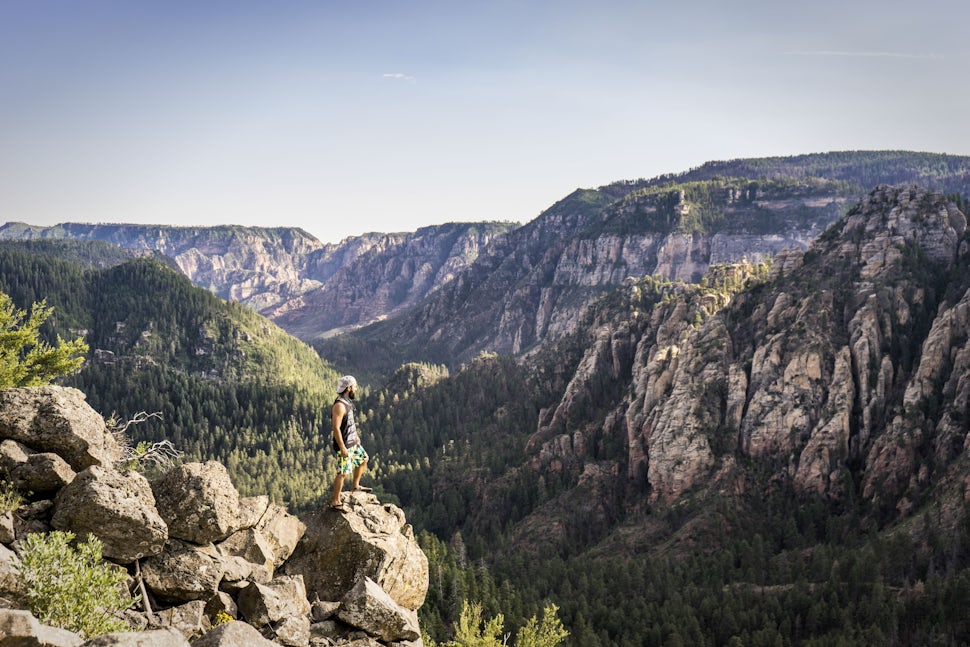How to Recognize Heat Exhaustion While Hiking
Here are five things to ask yourself to help you recognize and avoid overexertion and heat illness, with a personal story of how it happened to me.

On a recent hike, I encountered a scary situation. Overexertion complicated by heat exhaustion. This is something of which every hiker must be aware.
My brother and I decided to take a hike on Bear Mountain in Connecticut on a very hot day (the heat index was near 100˚). I’m an avid hiker, used to moderate to long distance day hikes and backpacking, but about a mile-and-a-half into the steep hike, I was gassed. I was well hydrated to start the hike, but I needed to stop and sit down. I was profusely sweating (a waterfall was coming from the brim of my hat), started to get tunnel vision, a headache, nausea, and had weakness in my legs. These were all the signs of overexertion complicated by the heat. My perspiration wasn’t cooling me down. The high heat and humidity of the day were making my body less efficient and effective at cooling
I’ve pushed myself to the limits in the past, but this was a frightening moment. My brother didn’t realize I had stopped and continued hiking. I tried to shout for him but couldn’t muster much of any sound. I felt like I was going to throw up and faint.
So let my experience be a lesson to you.
Photo: Nick Tort
Here are some tips for recognizing overexertion and heat exhaustion:
1) Are you sweating profusely?
If the humidity is high, perspiration isn’t as efficient and effective at cooling our bodies. This means our core temperature is rising and we’re losing a lot of water fast. Slow down and drink cool water. Stop in the shade or use local streams to cool off if necessary.
2) Do you have any nausea?
Your body will pull blood from the stomach and digestive track to fuel the large muscles, hence why your stomach starts to churn. This is common with endurance athletes who push themselves to the limit.
3) Is your heart rate really high, faint, and/or irregular?
A quick rule to determine your maximum heart rate is 220 – your age. If you are working for extended periods of time at 85% of maximum or higher you are really pushing yourself. Take a break to let your heart rate recover and slow down the pace.
4) Does your skin suddenly feel cool with goose bumps? Do you feel dizzy, faint, or have tunnel vision or a headache?
Heed these warning signs. Take a break. Sit down in the shade and cool off. Sip cool water. Electrolyte mixes can help recovery. Focus on breathing. When standing back up, do so slowly.
5) Are you thirsty? Muscles cramping?
Your body needs fluids. Thirst is your bodies way of telling you the tank is running low. I usually hike with a hydration bladder in my backpack, so I try to sip a few ounces every 15-20 minutes. When I stop for a quick break I like to stretch the legs (calves, quadriceps, and hamstrings) to prevent cramping.
Photo: Christopher Zajac
If you suffer these symptoms on the trail, especially if they don’t go away after a rest, it is highly advisable to get off the trail. Remember, as famous mountaineer Ed Viesturs says, “Getting to the top is optional. Getting down is mandatory.”
If drinking water, cooling down and rest don’t make you feel better within an hour, seek prompt medical attention. You may have heat stroke, which is a life-threatening condition.
Enjoy yourselves and safe hiking.
None of this is meant to constitute medical advice. I relied on my personal experiences and reputable sources (Mayo Clinic, Wedmd.com, first aid guides and others) to put this together. If you have concerns you should consult a medical professional before you hike.
Cover photo: Nick Tort
We want to acknowledge and thank the past, present, and future generations of all Native Nations and Indigenous Peoples whose ancestral lands we travel, explore, and play on. Always practice Leave No Trace ethics on your adventures and follow local regulations. Please explore responsibly!
Do you love the outdoors?
Yep, us too. That's why we send you the best local adventures, stories, and expert advice, right to your inbox.










